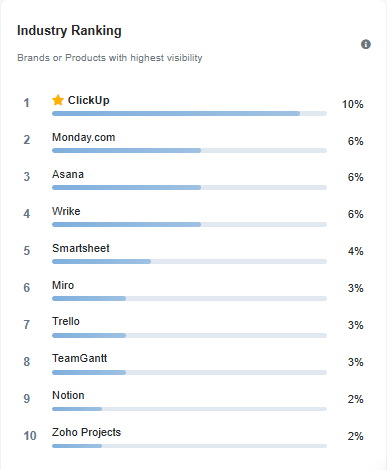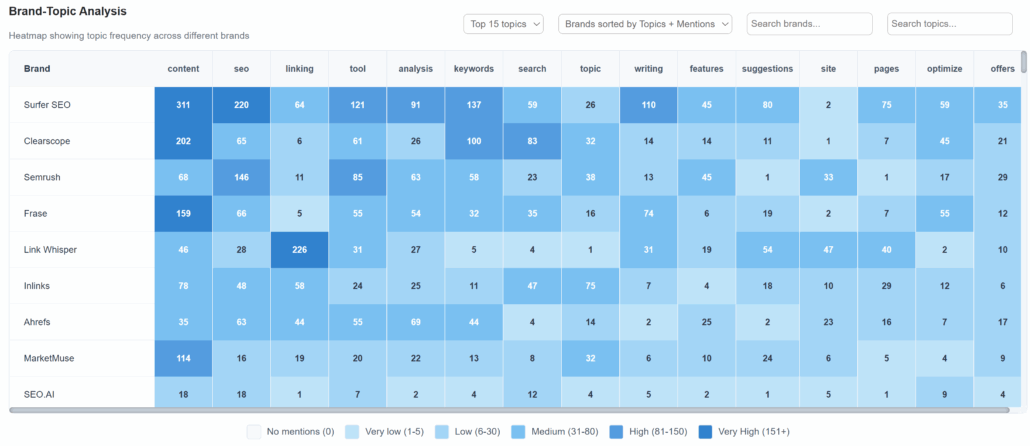The Missing Link in Your Marketing Strategy: AI Brand Visibility Tracking
Most marketing teams know how to track search rankings, monitor brand mentions and optimise for visibility. But a new challenge is quietly reshaping how customers discover and evaluate your brand: large language models.
Tools like ChatGPT, Claude, Gemini and Sonar are becoming central to the way people search, compare and make decisions. These models now shape brand visibility, deciding which products, companies or people show up in response to different prompts.
This is not just a technical shift. It is a strategic one.
AI Is Changing the Customer Journey
Before, a potential customer might Google “best moisturiser for dry skin” and see ten links. Now, they ask ChatGPT or Gemini and get one summarised answer. That answer may name specific brands. It may skip others entirely.

AI visibility is no longer a nice-to-have. It is becoming the front line of brand awareness and comparison. If your competitors are showing up in more prompts – and you are not – you are losing ground, even if your SEO is strong.
The Risks of Being Misunderstood or Missed Altogether
Earlier this year, Google’s AI summaries misidentified the plane involved in a high-profile crash. The error was brief but widely shared. That single moment shows just how visible and fallible AI outputs can be. Dixon Jones goes into this in a bit more detail here.
What if the same thing is happening to your brand?
· Are you being left out of prompt results where you should appear?
· Are your competitors being recommended more often, even with weaker products?
· Are language models presenting outdated or incomplete information?
These are no longer hypotheticals. They are already affecting how brands are seen, trusted and selected.
What Is AI Brand Visibility Tracking?
AI brand visibility tracking shows how your brand appears across different AI tools in response to natural language prompts. It reveals whether your brand is being surfaced for relevant queries, how it is described, and how you compare to competitors.
Pictured below is a heatmap from Waikay.io showing how different brands are ranking for specific entities in response to a particular AI prompt. The prompt is re-queried daily, and the heatmap updates automatically to reflect any changes.
In this example:
- Surfer SEO is consistently showing up when the AI talks about content-related topics.
- Meanwhile, Link Whisper is starting to dominate when it comes to linking-related entities.
This kind of tracking helps identify which brands are gaining visibility in different semantic areas of AI-generated responses.

Rather than focusing on keywords, AI visibility is structured around entities your company name, product names, founder, and core attributes. These are what language models use to construct their answers.
By tracking brand visibility across AI platforms, you can:
· Understand where you show up and where you don’t
· Fix inaccuracies or missing information
· Identify visibility gaps compared to your competitors
· Shape how customers encounter your brand in AI-led discovery
Why Visibility Beats Guesswork
Imagine you run a skincare brand:
· ChatGPT says your product is only for men, even though it’s unisex
· Claude fails to mention your cruelty-free status
· Gemini lists your competitor as the top option, despite weaker reviews
With visibility tracking, you would see these issues immediately and take action to correct them. This is what tools like Waikay.io are built for. Waikay scans how your brand and related entities show up in major AI platforms, from ChatGPT to Claude. Then it gives you structured reports and suggestions to improve your visibility where it matters most inside AI answers.
What Makes Waikay Different

While other tools may track crawlability or AI indexing, Waikay focuses directly on brand presence in actual language model outputs. It helps you:
· Audit your brand visibility across major AI tools
· Benchmark yourself against key competitors
· Identify what’s missing, what’s misleading and what to fix
· Take action using structured prompts and content guidance
You don’t just see problems. You get solutions fast.
Waikay is also built to be self-serve, affordable and fast. No enterprise pricing. No sales calls. Just actionable insights that help you win more space in AI results.
Start Competing on AI
In the past, visibility meant fighting for a spot on page one of Google. It was about ranking above your competitors, earning clicks, and optimising your content to match what the algorithm wanted. That still has value, but it is no longer the full picture.
Today, visibility means appearing in the first and often only answer generated by tools like ChatGPT, Claude, Gemini, or Sonar. These platforms are not offering a list of ten links. They are delivering a single response that may mention a few brands, recommend a specific product, or even summarise entire industries. If your name is not included, you are not just missing out on traffic – you are missing the conversation altogether.
AI is now influencing every step of the customer journey:
· When someone asks “What is the best moisturiser for sensitive skin?” and your competitor appears in the AI-generated answer but you don’t, the customer is already being nudged in their direction.
· When a journalist uses AI to research a story and your company is not mentioned, your visibility is gone before the story is even written.
· When an investor or partner searches for market leaders using AI tools, they are forming a perception based on what those tools return.
This is not about vanity metrics. It is about real, competitive presence in the spaces that are shaping how people discover, evaluate, and choose brands.
AI tools have become filters for attention. They influence who is seen, who is remembered, and who gets left out. Without visibility in those spaces, your brand can be overlooked even if your offering is stronger, more innovative, or more trusted than the competition.
The brands that start tracking and improving their AI visibility now will have a serious strategic advantage. They will not just be visible; they will be preferred.
Final Takeaway
If you’re still only tracking search rankings, you’re missing the new front of competition. AI brand visibility tracking is how you understand where your brand stands in the age of large language models — and how to move forward strategically.
Start with your name. Then your product. Then your founder. One entity at a time, you can take control of your AI presence — and start shaping the future of how your brand is found.
(Principal Author: Genie Jones. Editors: Nina Dabrowska and Dixon Jones)
